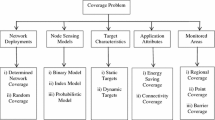Abstract
Wireless sensor networks have many applications in real life. We are given m sensors and n users on the plane. The coverage of each sensor s is a disc area, whose radius r(s) and energy p(s) satisfy that \( p(s)= r(s)^\alpha \), where \(\alpha \ge 1\) is the attenuation factor. In this paper, we study the energy-constrained geometric coverage problem, which is to find an energy allocation scheme such that the total energy does not exceed a given bound P, and the total profit of the covered points is maximized. We propose a greedy algorithm whose approximation ratio is \(1-\frac{1}{\sqrt{e}}\).
Access this chapter
Tax calculation will be finalised at checkout
Purchases are for personal use only
Similar content being viewed by others
References
Alt, H., Arkin, E.M., Brönnimann, H., et al.: Minimum-cost coverage of point sets by disks. In: Amenta, N., Cheong, O. (eds.) Symposium on Computational Geometry, pp. 449–458. ACM, New York (2006)
Bilò, V., Caragiannis, I., Kaklamanis, C., Kanellopoulos, P.: Geometric clustering to minimize the sum of cluster sizes. In: Brodal, G.S., Leonardi, S. (eds.) ESA 2005. LNCS, vol. 3669, pp. 460–471. Springer, Heidelberg (2005). https://doi.org/10.1007/11561071_42
Chekuri, C., Kumar, A.: Maximum coverage problem with group budget constraints and applications. In: Jansen, K., Khanna, S., Rolim, J.D.P., Ron, D. (eds.) APPROX/RANDOM 2004. LNCS, vol. 3122, pp. 72–83. Springer, Heidelberg (2004). https://doi.org/10.1007/978-3-540-27821-4_7
Dai, H., Deng, B., Li, W., et al.: A note on the minimum power partial cover problem on the plane. J. Comb. Optim. (2022). https://doi.org/10.1007/s10878-022-00869-8
Farbstein, B., Levin, A.: Maximum coverage problem with group budget constraints. Journal of Combinatorial Optimization 34, 725-735 (2017). https://doi.org/10.1007/s10878-016-0102-0
Feldman, M., Nutov, Z., Shoham, E.: Practical budgeted submodular maximization. arXiv:2007.04937 (2020)
Guo, L., Li, M., Xu, D.: Approximation algorithms for maximum coverage with group budget constraints. In: Gao, X., Du, H., Han, M. (eds.) COCOA 2017. LNCS, vol. 10628, pp. 362–376. Springer, Cham (2017). https://doi.org/10.1007/978-3-319-71147-8_25
Iyer, R., Bilmes, J.: Submodular optimization subject to submodular cover and submodular knapsack constraints. In: Koyejo, S., Agarwal, A. (eds.) Twenty-Seventh Conference on Neural Information Processing Systems, Lake Tahoe, Nevada, USA, vol. 2, pp. 2436–2444 (2013)
Khuller, S., Moss, A., Naor, J.: The budgeted maximum coverage problem. Inf. Process. Lett. 70(1), 39–45 (1999)
Kulik, A., Schwartz, R., Shachnai, H.: A refined analysis of submodular greedy. Oper. Res. Lett. 49, 507–514 (2021)
Li, W., Liu, X., Cai, X., Zhang, X.: Approximation algorithm for the energy-aware profit maximizing problem in heterogeneous computing systems. J. Parallel Distrib. Comput. 124, 70–77 (2019)
Liu, X., Li, W., Dai, H.: Approximation algorithms for the minimum power cover problem with submodular/linear penalties. Theoret. Comput. Sci. 923, 256–270 (2022)
Liu, X., Li, W., Xie, R.: A primal-dual approximation algorithm for the \(k\)-prize-collecting minimum power cover problem. Optim. Lett. (2021).https://doi.org/10.1007/s11590-021-01831-z
Liu, X., Li, W., Yang, J.: A primal-dual approximation algorithm for the \(k\)-prize-collecting minimum vertex cover problem with submodular penalties. Front. Comput. Sci. (2022). https://doi.org/10.1007/s11704-022-1665-9
Sviridenko, M.: A note on maximizing a submodular set function subject to a knapsack constraint. Oper. Res. Lett. 32(1), 41–43 (2004)
Tang, J., Tang, X., Lim, A., Han, K., Li, C., Yuan, J.: Revisiting modified greedy algorithm for monotone submodular maximization with a knapsack constraint. In: Proceedings of the ACM on Measurement and Analysis of Computing Systems, vol. 5, no. 1, pp. 1–22 (2021)
Wolsey, L.: Maximising real-valued submodular functions: primal and dual heuristics for location problems. Math. Oper. Res. 7(3), 410–425 (1982)
Yaroslavtsev, G., Zhou, S., Avdiukhin, D.: “Bring Your Own Greedy”+Max: near-optimal 1/2-approximations for submodular knapsack. In: Chiappa, S., Calandra, R. (eds.) International Conference on Artificial Intelligence and Statistics, Palermo, Sicily, Italy, pp. 3263–3274 (2020)
Zhang, H., Vorobeychik, Y.: Submodular optimization with routing constraints. In: Schuurmans, D, Wellman, M.P. (eds.) Proceedings of the 30th AAAI Conference on Artificial Intelligence, Lake Tahoe, Nevada, pp. 819–826 (2016)
Author information
Authors and Affiliations
Corresponding author
Editor information
Editors and Affiliations
Rights and permissions
Copyright information
© 2022 The Author(s), under exclusive license to Springer Nature Switzerland AG
About this paper
Cite this paper
Lan, H. (2022). Energy-Constrained Geometric Coverage Problem. In: Ni, Q., Wu, W. (eds) Algorithmic Aspects in Information and Management. AAIM 2022. Lecture Notes in Computer Science, vol 13513. Springer, Cham. https://doi.org/10.1007/978-3-031-16081-3_23
Download citation
DOI: https://doi.org/10.1007/978-3-031-16081-3_23
Published:
Publisher Name: Springer, Cham
Print ISBN: 978-3-031-16080-6
Online ISBN: 978-3-031-16081-3
eBook Packages: Computer ScienceComputer Science (R0)




